Coin Values Moving with Precious Metals: Up-Dated 4/14/2025: Gold $3226 | Silver $31.88
1933 Penny Value
A key variety to 1933 penny value is the "D" mint issue of Denver. Low production and lack of saving of these coins has created a premium variety. Proceed through the value process of inspecting: Date | Mint Mark | Condition
Secondly - Condition: Examples with light wear, indicating higher condition are uncommon and worth strong premiums.
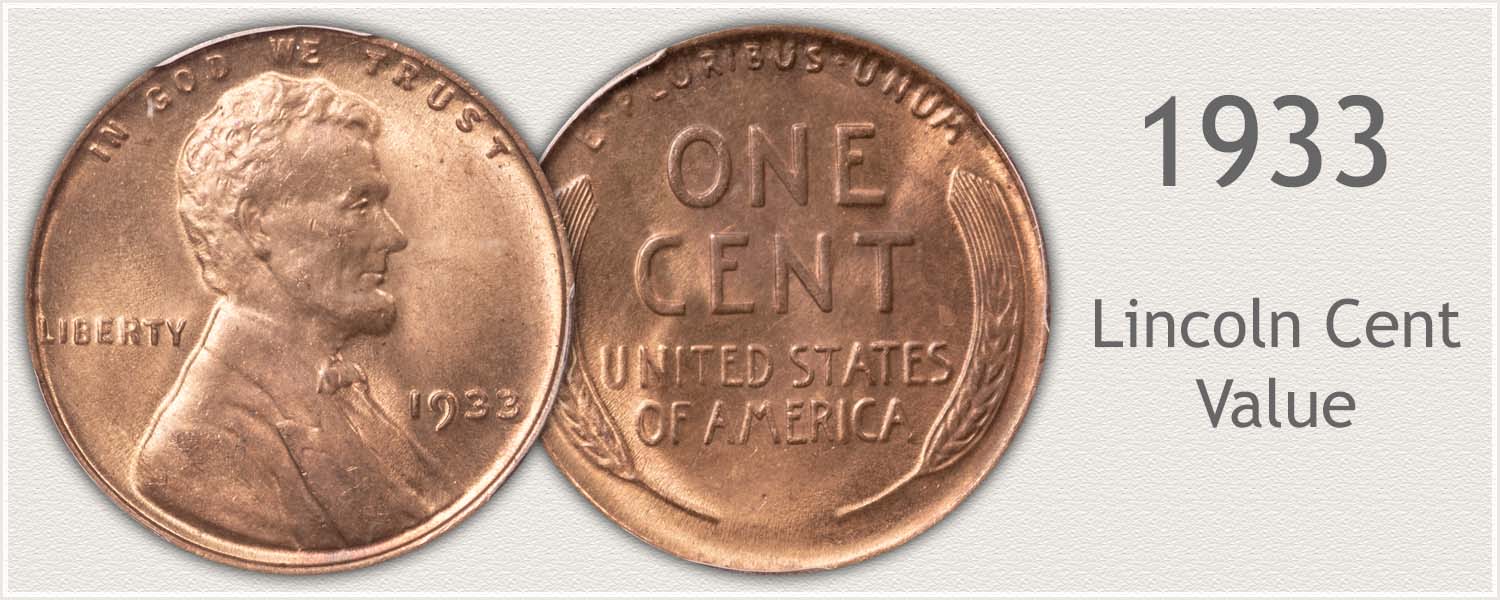
Steps Leading to Value:
- Step 1: Date and Mintmark Variety – Identify each date and its mintmark variety.
- Step 2: Grading Condition – Judge condition to determine grade. Comparing to images identifies grade.
- Step 3: Special Qualities – Certain elements either enhance or detract from value.
| 1933 Lincoln Penny Value | ||||
|---|---|---|---|---|
| Condition of Coin | ||||
| Date | Good | Fine | Extremely Fine | Uncirculated |
| 1933 Lincoln Penny Value Up-Dated | 2025 | |||
| 1933 | $1.00 | $1.96 | $5.09 | $12 |
| 1933 D | $2.33 | $4.77 | $11 | $15 |
Listed by date and mint mark variety the chart further narrows value by the condition of the coin. Grades of Good, Fine, Extremely Fine, and Uncirculated are described in the Grading Section below.
Whether its many or a few coins, judging each individually is important to an accurate value. Collectors follow a step by step approach of examining: Date | Mint Mark | Condition to determine how much they are worth.
Step one is identify and confirm the mint that struck the coin. Just below are images to locate any possible mint mark.
Give special attention to Grading Condition. Reading the value chart shows the increase in desirability of higher condition coins. In the Grading Section images are used to match your coin, inspecting for wear and subtle points to condition.
Step 1: | Date and Mintmark Combination
Exact Variety is Needed to 1933 Penny Value
Following a year of low cent production, 1933 saw an increased demand for minor coinage by the public as cited in the mint report. Although mintages increased, 1933 ranks as the 3rd lowest total mintage year. 20,560,000 cents struck by all mints. Another year of infrequently encountered pennies.
1933 Lincoln Penny
No Mintmark Under Date: Philadelphia Mint Struck the Coin
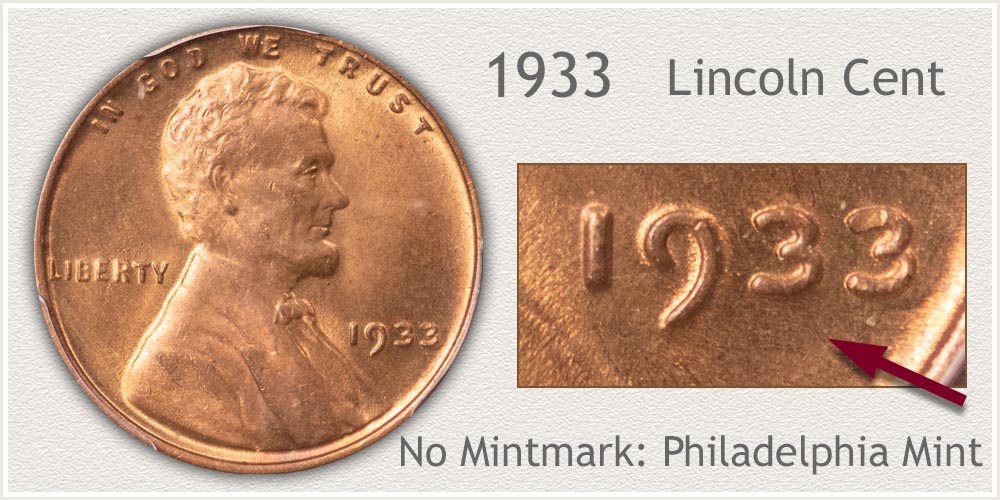
A nice starting value is found in 1933 Philadelphia cents. All grades are sought by collectors. Compare your coin to grading images in the next section to help visualize its condition. A wider value spread is noted among lightly circulated or better coins.
1933 is the considered by collectors as the final year of early era wheat cents. Need for the year as part of collections creates demand, supporting strong value.
1933-D Lincoln Penny
"D" Mintmark Under Date: Denver Mint Struck the Coin
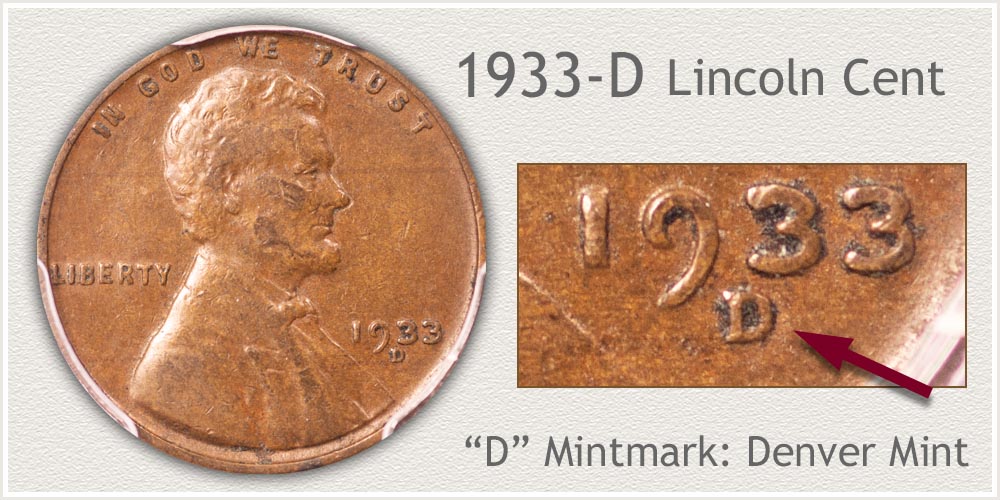
A somewhat elusive coin in pleasing condition. Mintage numbers are on the lower end, 6,200,000 and most saw use in commerce receiving extensive wear. A small change to style by enlarging the "D" mintmark adds to interest and allure of these coins.
Eye appealing, lightly worn examples are a standout coin. A shape rise in demand for pleasing coins is noted on value chart. Detailed lettering along the rims on both sides indicates a quality collectible condition.
Step 2: | Judge Condition to Identify Grade
Examine Condition of 1933 Penny
A 1933 penny is firmly in the numismatic collectible group of wheat cents. Historic value is high. Grading determines aesthetic value to collectors. A grade defines its state of condition and is used by collectors to help judge its worth.
Handle the coin gently, hold the edges only avoiding touching the surface. Copper reacts to most elements. A couple precautions helps preserve the future condition of the coin.
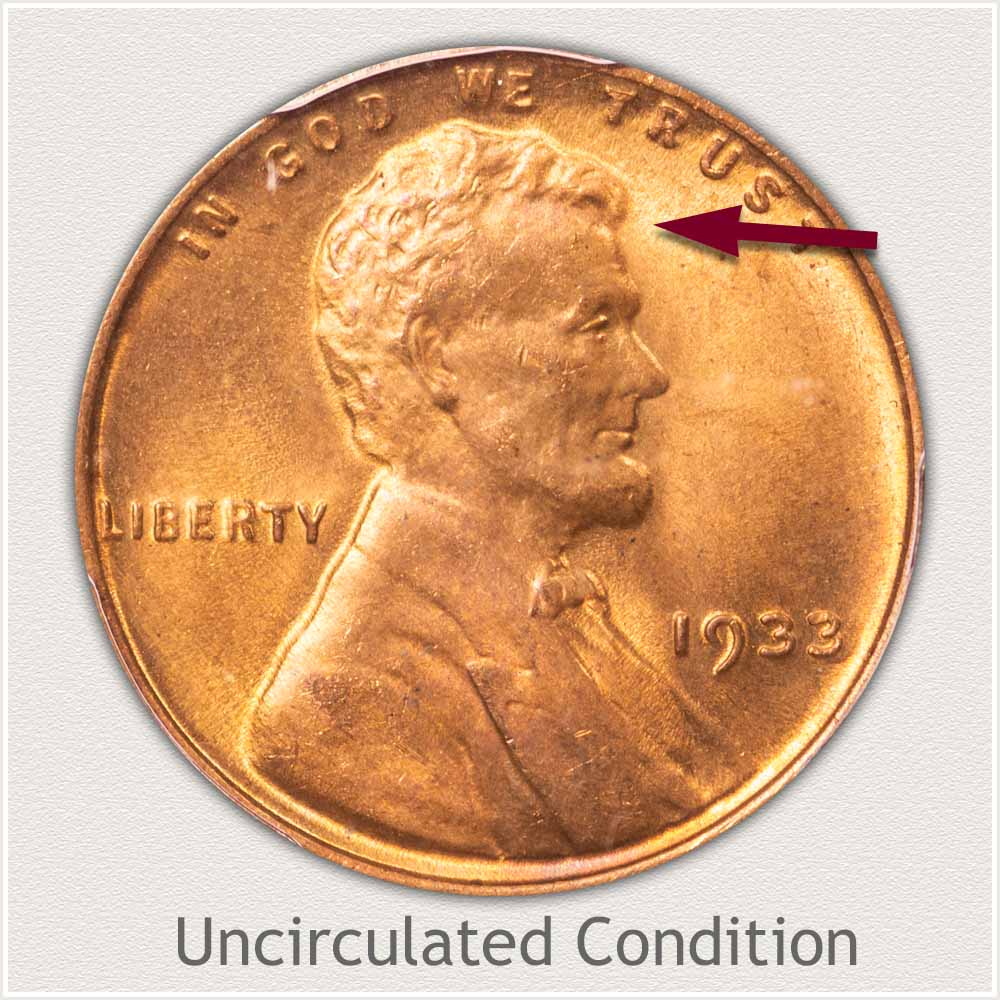
Uncirculated Grade: An uncirculated 1933 cent shows no signs of wear to any surface of design, legends, and fields. Mint frost, imparted at the time of striking remains undisturbed.
One area high in profile is Lincoln's forehead and waves of hair just above. A low relief area separates these forming the hair line. Somewhat protected by the height of the rim, waves of hair are high enough to use as an indicator of wear. Luster remaining on both the forehead and uppermost parts of hair confirms a mint state grade.
Uniform, bright color is displayed by this mint state 1933 penny. coin. Detecting wear to the surface is identifying a smoothing to the metal.
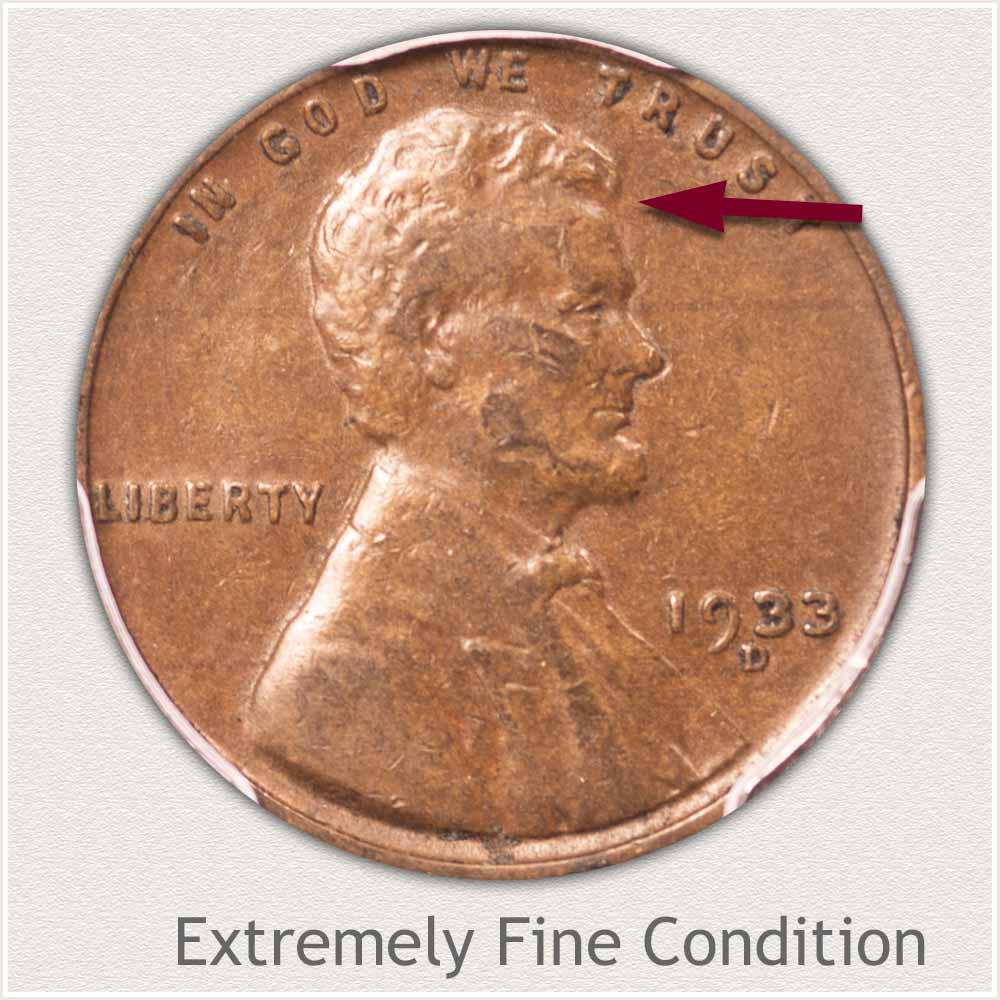
Extremely Fine Grade: As a coin begins to wear small areas of flatness appear on high points. Slight wear defines a coin in Extremely Fine grade.
Lincoln's forehead is beginning to show signs of smoothing and a small area of flatness is evident. Waves of hair above the forehead are slightly flattened on their crests. Remaining features within the hair are well defined confirming an extremely fine grade.
Subtle shades of brown contrast and highlight details on this 1933-D penny. A natural look lends eye appeal and is favored in the market. A collectible grade and mint, in a premium grade.
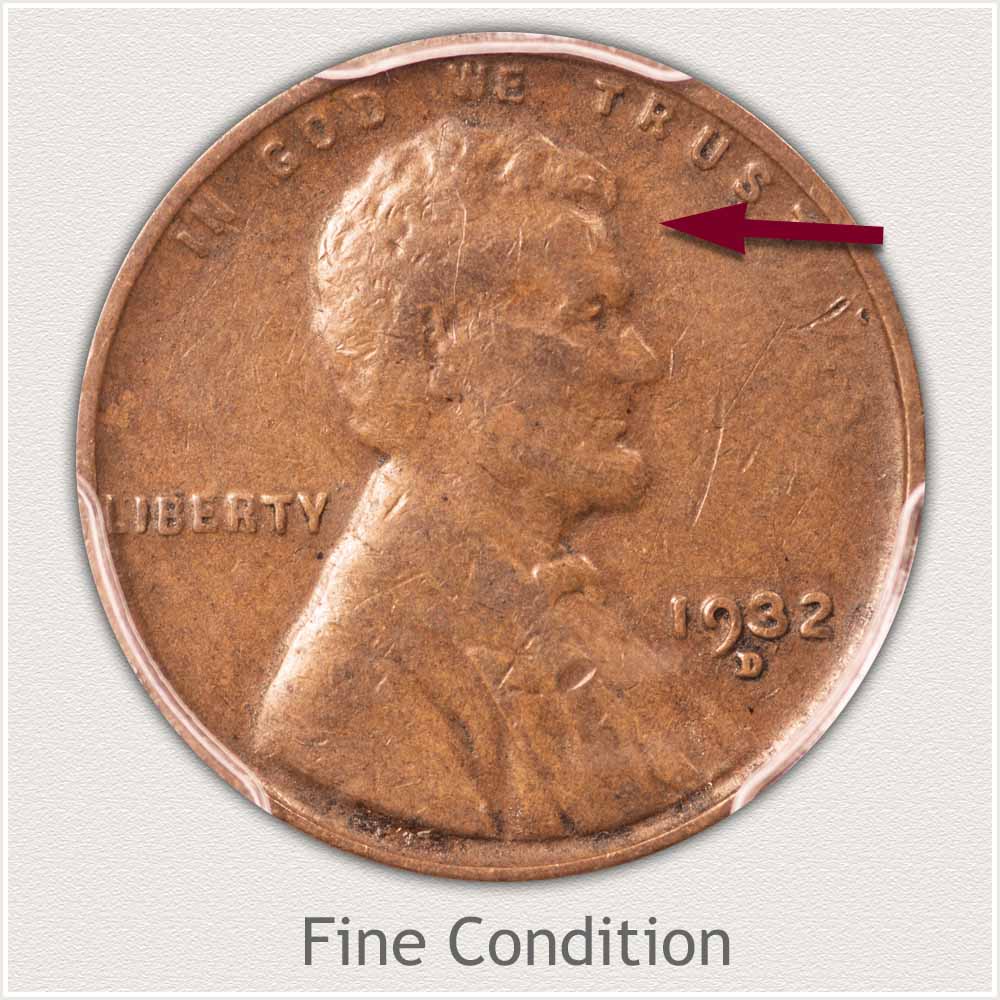
Fine Grade: Moderate wear with major design elements remaining defines a wheat penny in Fine grade. Smoothing leaves finer details missing. Lincoln's forehead remains contoured with no wide-spread flatting evident.
Waves of hair at the top of Lincoln's head are beginning to merge with flat spots on the very top edges. Hair details along the forehead are somewhat faded. A separation of hair from the temple area is faint but evident.
Important to value is a pleasing natural color and mark free surfaces to these old wheat cents. Light brown toning covers the majority of the surface with deeper shades within the recesses and fields presenting an appealing collectible coin.

Good Grade: Extensive wear, creating large areas of flatness, is graded Good condition. Within the central area, all contours of Lincoln's face are worn to one smooth surface. A large connection is evident with forehead, ear, and hair.
Hair at the top of Lincoln's head is mostly flat. Minor waves of hair have merged leaving only major details separated. His forehead is very flat with little contour separating the hair line.
As a coin becomes heavily worn, the number of recognizable features adds to value. Legends separated from the rim is a plus. A bold date is important. This 1933-D with a technical grade of Good combined with pleasing eye appeal is strong for the grade.
Video | Grading Lincoln Wheat Pennies
Detecting wear and condition by examining all parts of the coin's surface confirms a grade. As values climb higher many additional factors are used to decide the grade and worth.
Grading Lincoln Wheat Pennies covers the grading process in greater detail. Video examines grading examples. Descriptions point to elements to establish a grade.
Step 3: | Special Qualities Enhancing Value
1933 Penny | Early Year Status
1933 is a significant year in the wheat cents series, representing the last year of the value era 1909 to 1933. Two major eras are noted for wheat cents, early years, all worth well above base value. Second era 1934 through 1958 when the majority of moderately circulated examples are readily available and worth a few cents each.
Any 1933 wheat cent is a premium find both in value and collectability. As an early year it fits into many collecting themes. Experienced collectors assembling date and mint sets recognize the scarcity, few were minted in comparison to other years. Beginning collectors who focus on affordable later year collections see an opportunity to add a very old wheat cent representation.
Collecting preferences always tend towards higher condition examples of any coin. Demand for these coins has established a distinction with the grade Extremely Fine and better. A large value gap identifies an elusive coin in these grades.
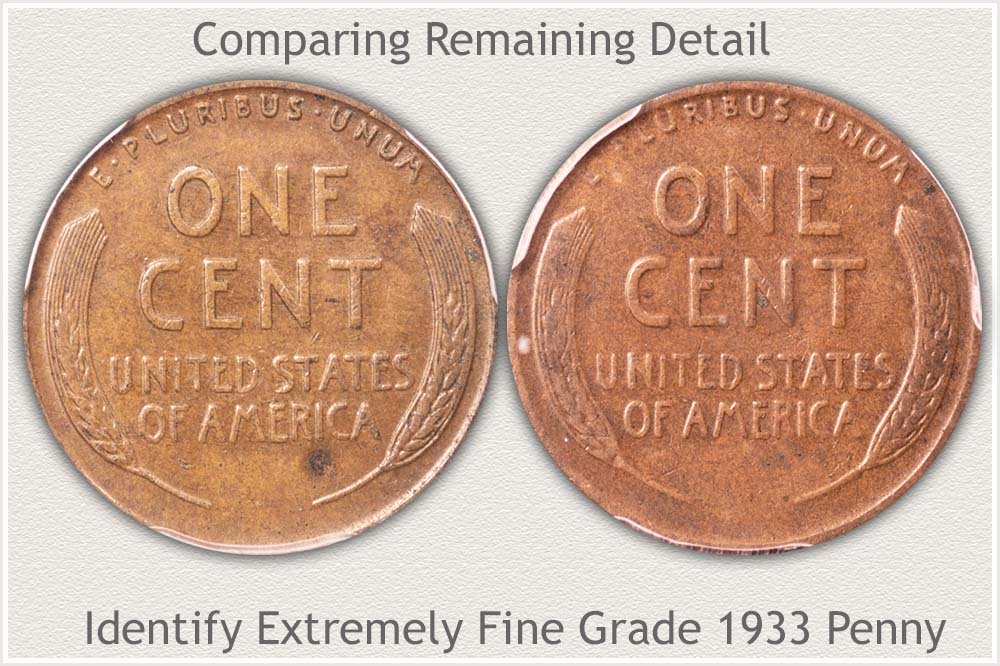
Compare the reverse detail of the Extremely Fine grade 1933 cent to the reverse of one that just missies this elusive grade. A subtle amount of wear has removed enough detail and is beginning to merge the small lines towards edges of the wheat stalk design. A small point, however, in extremely fine grade only a fraction of the original mintage remains in this condition or better.
References
US Mint. 1934 US Mint Annual Report
https://nnp.wustl.edu/library/publisherdetail/51
Federal Trade Commission. Investing in Collectible Coins. https://www.consumer.ftc.gov/articles/0136-investing-collectible-coins
Coin Values | CoinStudy Articles
Lincoln Wheat cents span the years 1909 through 1958. From the top condition coins collected by advanced collectors to worn examples; to an affordable collection for young collectors, the range of value is extensive. Identify your date, mint and condition and refer to the value chart.
Rare pennies are identified in series from wheat cents back to the early years of the US Mint. These one-cent and half-cents coins first struck in 1793 have a number of stand-out issues.
★ Coin Values Discovery finds 1933 Penny Value and...
US coin value charts covering cents to gold. Identify your coins using the image links. Date | Mintmarks | Condition are described and imaged with each series. Small details necessary to accurately value are described.